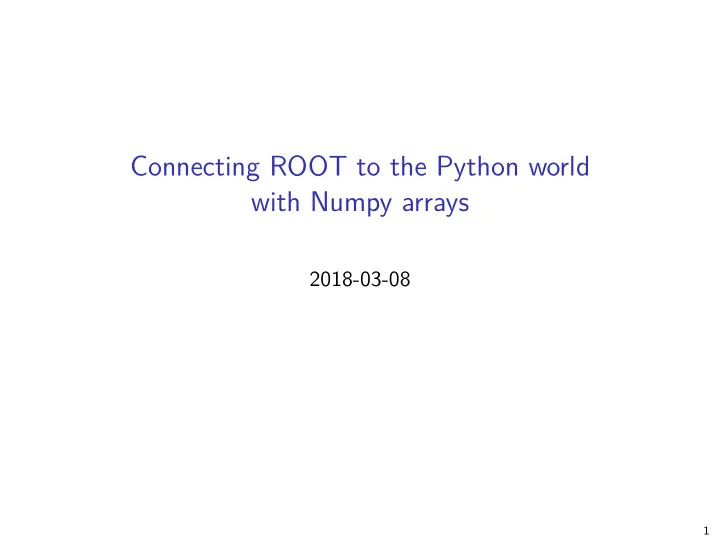

Connecting ROOT to the Python world with Numpy arrays 2018-03-08 1
What is the idea? ◮ Numpy arrays are the interface for all of the scientific libraries in the Python world (scipy, sklearn, tensorflow, matplotlib, . . . ). ◮ The desired interface would look like this: >>> import ROOT >>> import numpy as np >>> x = ROOT.TSomeObjectWithContiguousData() >>> y = np.asarray(x) # <- Zero-copy operation! >>> print(y.shape) (num_dim_1, num_dim_2, ...) There are two solutions to make this possible → 2
Reminder: Memory-layout of Numpy arrays Documentation: Link An instance of class ndarray consists of a contiguous one-dimensional segment of computer memory (owned by the array, or by some other object), combined with an indexing scheme that maps N integers into the location of an item in the block. The ranges in which the indices can vary is specified by the shape of the array. 3
Short-term solution: The (Numpy) array interface ◮ Adding the __array_interface__ magic to ROOT Python objects (Documentation) ... >>> x = ROOT.TSomeObjectWithContiguousData() >>> print(x.__array_interface__) # This is a dictionary! { "version": 3, # Version of the array interface "shape" : (100, 4), # Shape information "typestr" : "<f4", # 4-byte float, little endian "data" : [12345678, False], # Pointer to first element, read-only flag ... # There are more optional fields to support C-style structs, offsets, masks, strides, ... } >>> y = np.asarray(x) # Zero-copy operation, adopts the memory >>> print(y.shape) (100, 4) ◮ This can happen in the Pythonization-layer of PyROOT. ◮ Fast and cheap solution. 4
Long-term solution: The buffer protocol Description found here: Certain objects available in Python wrap access to an underlying memory array or buffer. Such objects include the built-in bytes and bytearray , and some extension types like array.array . Third-party libraries may define their own types for special purposes, such as image processing or numeric analysis. Basic structure , defined in the module source: typedef struct bufferinfo { void *buf; PyObject *obj; Py_ssize_t len; Py_ssize_t itemsize; int readonly; int ndim; char *format; Py_ssize_t *shape; Py_ssize_t *strides; Py_ssize_t *suboffsets; void *internal; } Py_buffer; int PyObject_GetBuffer(PyObject *obj, Py_buffer *view, int flags); Numpy (and others) understand the buffer protocol: ... >>> x = ROOT.TSomeObjectWithContiguousData() # Python object implements the buffer protocol >>> y = np.asarray(x) # Zero-copy operation >>> print(y.shape) (num_dim_1, num_dim_2, ...) 5
Recommend
More recommend